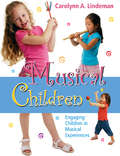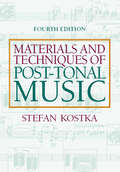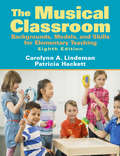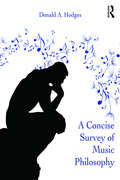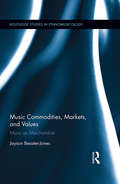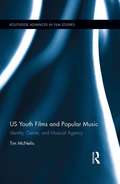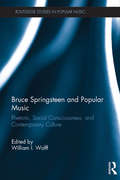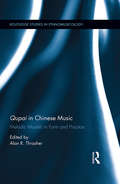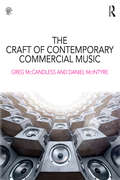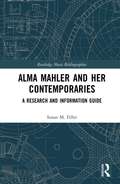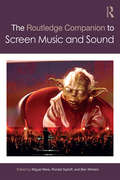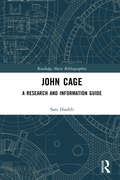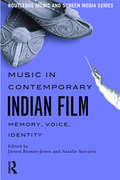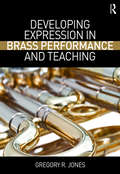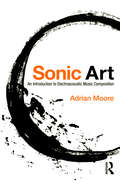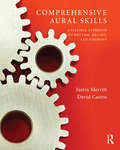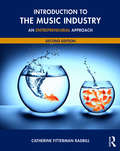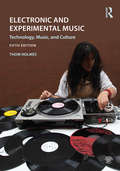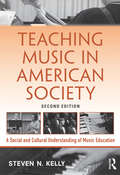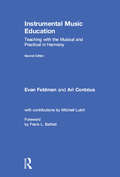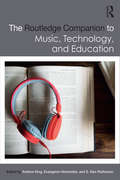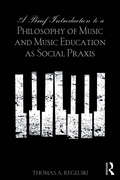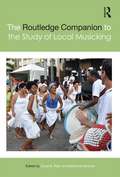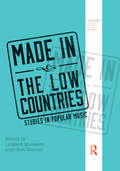- Table View
- List View
Musical Children, CD: Engaging Children in Musical Experiences
by Carolynn LindemanMusical Children: Engaging Children in Musical Experiences by Carolyn Lindeman is the only text that focuses on the teaching of preschool and kindergarten students and the important role music plays in a their educations and lives. Music educators are increasingly recognizing the importance of teaching musical skills as early as the preschool years. This book presents the latest research emphasizing real life applications so that teachers can achieve their goal of creating more musically creative children. The book presents 25 strategies for engaging children who are learning music based on the latest Music Educators National Conference (MENC) standards. It includes reproducible student activity charts, a song selection of 40 notated melodies, a collection of chants, and resource materials for any new teacher to reference. Musical Children is not only an excellent text in any Music Education classroom, but an excellent resource for any preschool or kindergarten teacher. Written by a leading authority on early childhood music education, the text will be used in courses on Elementary Methods and Fundamentals of Music Education. Audio-CD not for sale. Available for instructors upon request from Sales office
Materials and Techniques of Post Tonal Music
by Stefan KostkaThis text provides the most comprehensive analytical approach to post-tonal music available, from Impressionism to recent trends. It covers music from the early 1900s through the present day, with discussion of such movements as Minimalism and the Neoromanticism, and includes chapters on rhythm, form, electronic and computer music, and the roles of chance and choice in post-tonal music. Chapter-end exercises involve drills, analysis, composition, as well as several listening assignments.
Musical Classroom: Backgrounds, Models, and Skills for Elementary Teaching
by Carolynn LindemanWith this Eighth Edition, The Musical Classroom celebrates thirty years as a leading resource for future and in-service teachers as they engage children in the exciting world of music! Teachers, with the help of this user-friendly text, can develop the understandings and skills needed to teach elementary school music. The forty-four model lessons are the centerpiece to the book's long-lasting success. A collection of over 170 children's songs from around the world; instructional information for learning to play the recorder, keyboard, guitar, and Autoharp(TM); and the theoretical, pedagogical, and practical backgrounds needed for reaching all learners complete the comprehensive resource of The Musical Classroom. Note: This is the standalone book. If you want the accompanying audio CD, order the ISBN 9781138656703, which is available for separate sale.
Basic Conducting Techniques
by Joseph A. LabutaBasic Conducting Techniques is a practical and innovative textbook that provides sound, time tested procedures and material for the beginning conducting class. Students and professors have responded enthusiastically to the hands-on, conductor competency approach of this student-oriented textbook with its clearly stated objectives and performance tests. NOTE: This is the standalone book. If you want the accompanying Media DVD, order the ISBN 9780136011941.
A Concise Survey of Music Philosophy
by Donald A. HodgesA Concise Survey of Music Philosophy helps music students choose a philosophy that will guide them throughout their careers. The book is divided into three sections: central issues that any music philosophy ought to consider (e.g., beauty, emotion, and aesthetics); secondly, significant philosophical positions, exploring what major thinkers have had to say on the subject; and finally, opportunities for students to consider the ramifications of these ideas for themselves. Throughout the book, students are encouraged to make choices that will inform a philosophy of music and music education with which they are most comfortable to align. Frequently, music philosophy courses are taught in such a way that the teacher, as well as the textbook used, promotes a particular viewpoint. A Concise Survey of Music Philosophy presents the most current, prevalent philosophies for consideration. Students think through different issues and consider practical applications. There are numerous musical examples, each with links from the author’s home website to online video performances. Examples are largely from the Western classical canon, but also jazz, popular, and world music styles. In the last two chapters, students apply their views to practical situations and learn the differences between philosophy and advocacy. "Hodges has written an excellent resource for those wanting a short—but meaningful—introduction to the major concepts in music philosophy. Applicable to a number of courses in the music curriculum, this much-needed book is both accessible and flexible, containing musical examples, tables and diagrams, and additional readings that make it particularly useful for a student's general introduction to the topic. I especially like the emphasis on the personal development of a philosophical position, which makes the material especially meaningful for the student of music." —Peter R. Webster, Scholar-in-Residence, Thornton School of Music, University of Southern California, USA
Music Commodities, Markets, and Values: Music as Merchandise (Routledge Studies in Ethnomusicology)
by Jayson Beaster-JonesThis book examines music stores as sites of cultural production in contemporary India. Analyzing social practices of selling music in a variety of retail contexts, it focuses upon the economic and social values that are produced and circulated by music retailers in the marketplace. Based upon research conducted over a volatile ten-year period of the Indian music industry, Beaster-Jones discusses the cultural histories of the recording industry, the social changes that have accompanied India’s economic liberalization reforms, and the economic realities of selling music in India as digital circulation of music recordings gradually displaced physical distribution. The volume considers the mobilization of musical, economic, and social values as a component of branding discourses in neoliberal India, as a justification for new regimes of legitimate use and intellectual property, as a scene for the performance of cosmopolitanism by shopping, and as a site of anxiety about transformations in the marketplace. It relies upon ethnographic observation and interviews from a variety of sources within the Indian music industry, including perspectives of executives at music labels, family-run and corporate music stores, and hawkers in street markets selling counterfeit recordings. This ethnography of the practices, spaces, and anxieties of selling music in urban India will be an important resource for scholars in a wide range of fields, including ethnomusicology, anthropology, popular music studies, and South Asian studies.
US Youth Films and Popular Music: Identity, Genre, and Musical Agency (Routledge Advances in Film Studies)
by Tim McNelisThis book brings theory from popular music studies to an examination of identity and agency in youth films while building on, and complementing, film studies literature concerned with genre, identity, and representation. McNelis includes case studies of Hollywood and independent US youth films that have had commercial and/or critical success to illustrate how films draw on specific discourses surrounding popular music genres to convey ideas about gender, race, ethnicity, sexuality, and other aspects of identity. He develops the concept of ‘musical agency’, a term he uses to discuss the relationship between film music and character agency, also examining the music characters listen to and discuss, as well as musical performances by the characters themselves
Bruce Springsteen and Popular Music: Rhetoric, Social Consciousness, and Contemporary Culture (Routledge Studies in Popular Music)
by William WolffThis interdisciplinary volume enters the scholarly conversation about Bruce Springsteen at the moment when he has reinforced his status of global superstar and achieved the status of social critic. Covering musical and cultural developments, chapters primarily consider work Springsteen has released since 9/11—that is, released during a period of continued global unrest, economic upheaval, and social change—under the headings Politics, Fear and Society; Gender and Sexual Identity; and Toward a Rhetoric of Springsteen. The collection engages Springsteen and popular music as his contemporary work is just beginning to be understood in terms of its impact on popular culture and music, applying new areas of inquiry to Springsteen and putting Springsteen fan writing within the same binding as academic writing to show how together they create a more nuanced understanding of an artist. Established and emerging Springsteen scholars approach work from disciplines including rhetoric and composition, historical musicology, labor studies, American history, literature, communications, sociology, theology, and government. Offering context, critique, and expansive understanding of Springsteen and his work, this book contributes to Springsteen scholarship and the study of popular music by showing Springsteen’s broadening academic appeal as well as his escalating legacy on new musicians, social consciousness, and contemporary culture.
Qupai in Chinese Music: Melodic Models in Form and Practice (Routledge Studies in Ethnomusicology)
by Alan R ThrasherPresenting the latest research in the area, this volume explores the fundamental concept of qupai 曲牌, melodic models upon which most traditional Chinese instrumental music (and some vocal music) is based. The greater part of the traditional instrumental repertoire has emerged from qupai models by way of well-established 'variation' techniques. These melodies and techniques are alive today and still performed in 'silk-bamboo' types of ensemble music, zheng 箏, pipa 琵琶 and other solo traditions, all opera types, narrative songs, and Buddhist and Daoist ritual music. With a view toward explaining qupai as a musical system, contributors explore the concept from multiple directions, notably its historic development, patterns of structural organization, compositional usage in Kunqu classical opera, influence on the growth of traditional ensemble and solo repertoires, and indeed on 19th-century European music as well. Related essays examine the use of shan'ge 山歌 folksongs as qupai models in one local opera tradition and the controversial relationship between qupai forms and the metrically-organized banqiang 板腔 forms of organization in Beijing opera. The final three essays are focused upon traditional suite forms in which qupai and non-qupai tunes are mixed, examples drawn from the Minnan nanguan 南管 repertoire, Jiangnan 'silk-bamboo' tradition and the ritual music of North China.This is the first Western-language study on the nature and background of the qupai tradition, and the methods by which model melodies have been varied in creation of repertoire. The volume is essential reading for East Asian music specialists and contributes to the fields of ethnomusicology, musicology, music theory, music composition, and Chinese music and performing arts.
The Craft of Contemporary Commercial Music
by Greg McCandless Daniel McIntyreIn the contemporary world, the role of the commercial composer has grown to include a wide range of new responsibilities. Modern composers not only write music, but also often need to perform, record, and market their own works. The Craft of Contemporary Commercial Music prepares today’s music students for their careers by teaching them to compose their own music, produce it professionally, and sell it successfully. The textbook integrates three areas of concentration—music theory and composition, audio engineering, and music business—allowing students to understand and practice how to successfully navigate each stage of a score’s life cycle from concept to contract. Students will learn how to: Translate musical ideas into scores utilizing music theory and composition techniques Transform scores into professional audio through the production stages of tracking, sequencing, editing, mixing, mastering, and bouncing Market works to prospective clients The textbook assumes no prior knowledge of music theory or audio topics, and its modular organization allows instructors to use the book flexibly. Exercises at the end of each chapter provide practice with key skills, and a companion website supports the book with video walkthroughs, streaming audio, a glossary, and printable exercise pages. Combining a grounding in music notation and theory concepts with a foundation in essential technologies, The Craft of Contemporary Commercial Music offers an innovative approach that addresses the needs of students preparing for music careers.
Alma Mahler and Her Contemporaries: A Research and Information Guide (Routledge Music Bibliographies)
by Susan M. FillerThis selective annotated bibliography places Alma Mahler with three other female composers of her time, covering the first generation of active female composers in the twentieth century. It uncovers the wealth of resources available on the lives and music of Mahler, Florence Price, Yuliya Lazarevna Veysberg, and Maria Teresa Prieto and supports emerging scholarship and inquiry on four women who experienced both entrenched sexual discrimination and political upheaval, which affected their lives and influenced composers of subsequent generations.
The Routledge Companion to Screen Music and Sound
by Ben Winters Miguel Mera Ronald SadoffThe Routledge Companion to Screen Music and Sound provides a detailed and comprehensive overview of screen music and sound studies, addressing the ways in which music and sound interact with forms of narrative media such as television, videogames, and film. The inclusive framework of "screen music and sound" allows readers to explore the intersections and connections between various types of media and music and sound, reflecting the current state of scholarship and the future of the field. A diverse range of international scholars have contributed an impressive set of forty-six chapters that move from foundational knowledge to cutting edge topics that highlight new key areas. The companion is thematically organized into five cohesive areas of study: Issues in the Study of Screen Music and Sound—discusses the essential topics of the discipline Historical Approaches—examines periods of historical change or transition Production and Process—focuses on issues of collaboration, institutional politics, and the impact of technology and industrial practices Cultural and Aesthetic Perspectives—contextualizes an aesthetic approach within a wider framework of cultural knowledge Analyses and Methodologies—explores potential methodologies for interrogating screen music and sound Covering a wide range of topic areas drawn from musicology, sound studies, and media studies, The Routledge Companion to Screen Music and Sound provides researchers and students with an effective overview of music’s role in narrative media, as well as new methodological and aesthetic insights.
John Cage: A Research and Information Guide (Routledge Music Bibliographies)
by Sara HaefeliThis annotated bibliography uncovers the wealth of resources available on the life and music of John Cage, one of the most influential and fascinating composers of the twentieth-century. The guide will focus on documentary studies, archival resources, scholarly research, and autobiographical materials, and place the composer and his work in a larger context of postmodern philosophy, art and theater movements, and contemporary politics. It will support emerging scholarship and inquiry for future research on Cage, with carefully selected sources and useful annotations.
Music in Contemporary Indian Film: Memory, Voice, Identity
by Jayson Beaster-Jones Natalie SarrazinMusic in Contemporary Indian Film: Memory, Voice, Identity provides a rich and detailed look into the unique dimensions of music in Indian film. Music is at the center of Indian cinema, and India’s film music industry has a far-reaching impact on popular, folk, and classical music across the subcontinent and the South Asian diaspora. In twelve essays written by an international array of scholars, this book explores the social, cultural, and musical aspects of the industry, including both the traditional center of "Bollywood" and regional film-making. Concentrating on films and songs created in contemporary, post-liberalization India, this book will appeal to classes in film studies, media studies, and world music, as well as all fans of Indian films.
Developing Expression in Brass Performance and Teaching
by Gregory R. JonesDeveloping Expression in Brass Performance and Teaching helps university music teachers, high school band directors, private teachers, and students develop a vibrant and flexible approach to brass teaching and performance that keeps musical expression central to the learning process. Strategies for teaching both group and applied lessons will help instructors develop more expressive use of articulation, flexibility in sound production, and how to play with better intonation. The author shares strategies from today’s best brass instrument performers and teachers for developing creativity and making musical expression central to practicing and performing. These concepts presented are taken from over thirty years of experience with musicians like Wynton Marsalis, Barbara Butler, Charles Geyer, Donald Hunsberger, Leonard Candelaria, John Haynie, Bryan Goff, members of the Chicago Symphony and New York Philharmonic and from leading music schools such as the Eastman School of Music, The University of North Texas and The Florida State University.? The combination of philosophy, pedagogy, and common sense methods for learning will ignite both musicians and budding musicians to inspired teaching and playing.
Sonic Art: An Introduction to Electroacoustic Music Composition
by Adrian MooreWritten by an active composer, performer and educator, Sonic Art: An Introduction to Electroacoustic Music Composition provides a clear and informative introduction to the compositional techniques behind electroacoustic music. It brings together theory, aesthetics, context and practical applications to allow students to start thinking about sound creatively, and gives them the tools to compose meaningful sonic art works. In addition to explaining the techniques and philosophies of sonic art, the book examines over forty composers and their works, introducing the history and context of notable pieces, and includes chapters on how to present compositions professionally, in performance and online. The book is supported by an online software toolkit which enables readers to start creating their own compositions. Encouraging a ‘hands on’ approach to working with sound, Sonic Art is the perfect introduction for anyone interested in electroacoustic music and crafting art from sounds.
Comprehensive Aural Skills: A Flexible Approach to Rhythm, Melody, and Harmony
by David Castro Justin MerrittComprehensive Aural Skills is a complete suite of material for both performance and dictation, covering the wide range of sight singing and ear training skills required for undergraduate courses of study. It provides a series of instructional modules on rhythm, melody, and harmony, and blends musical examples from the common-practice repertory with original examples composed to specifically address particular skills and concepts. Each module includes material for classroom performance, self-directed study, and homework assignments. Features A complete suite of aural skills material: Comprehensive Aural Skills is a combined sight singing and ear training textbook, audio, and companion website package. Fully modular, customizable organization: Instructors can choose freely from the set of exercises in the book and supplemental material on the companion website to appropriately tailor the curriculum based on their students’ needs. Engaging and idiomatic musical examples: Examples are selected and composed specifically for the didactic context of an aural skills classroom. Dictation exercises for practice and assignment: Practice exercises include an answer key so students can work independently and receive immediate feedback, while homework assignments are given without a key. Audio examples for dictation: The website hosts live recordings of acoustic instruments performed by professional musicians for each dictation exercise and homework assignment. Supplemental Materials for Instructors: A wealth of material for class use and assignment can be found on the companion website. Teachers Guide: The guide includes answers for every homework assignment, brief commentary on each module’s content, tips for integrating written theory, and strategies on how to effectively teach new concepts and skills. The companion website for Comprehensive Aural Skills includes a wealth of additional examples in all areas of aural skills and at every level of difficulty represented in the text. Students have access to additional dictation examples with recordings and answer keys, allowing them to directly reinforce their classroom experience and practice dictation on their own time.
Introduction to the Music Industry: An Entrepreneurial Approach, Second Edition
by Catherine Fitterman RadbillIntroduction to the Music Industry: An Entrepreneurial Approach, Second Edition is an introductory textbook that offers a fresh perspective in one of the fastest-changing businesses in the world today. It engages students with creative problem-solving activities, collaborative projects and case studies as they explore the inner workings of the music business, while encouraging them to think like entrepreneurs on a path toward their own successful careers in the industry. This new edition includes a revised chapter organization, with chapters streamlined to focus on topics most important to music business students, while also maintaining its user-friendly chapter approach. Supported by an updated companion website, this book equips music business students and performance majors with the knowledge and tools to adopt and integrate entrepreneurial thinking successfully into practice and shape the future of the industry.
Electronic and Experimental Music: Technology, Music, and Culture (Media And Popular Culture Ser.)
by Thom HolmesElectronic and Experimental Music: Technology, Music, and Culture provides a comprehensive history of electronic music, covering key composers, genres, and techniques used in analog and digital synthesis. This textbook has been extensively revised with the needs of students and instructors in mind. The reader-friendly style, logical organization, and pedagogical features of the fifth edition allow easy access to key ideas, milestones, and concepts. New to this edition: * A companion website, featuring key examples of electronic music, both historical and contemporary. * Listening Guides providing a moment-by-moment annotated exploration of key works of electronic music. * A new chapter--Contemporary Practices in Composing Electronic Music. * Updated presentation of classic electronic music in the United Kingdom, Italy, Latin America, and Asia, covering the history of electronic music globally. * An expanded discussion of early experiments with jazz and electronic music, and the roots of electronic rock. * Additional accounts of the vastly under-reported contributions of women composers in the field. * More photos, scores, and illustrations throughout. The companion website features a number of student and instructor resources, such as additional Listening Guides, links to streaming audio examples and online video resources, PowerPoint slides, and interactive quizzes.
Teaching Music in American Society: A Social and Cultural Understanding of Music Education
by Steven N. KellySuccessful professional music teachers must not only be knowledgeable in conducting and performing, but also be socially and culturally aware of students, issues, and events that affect their classrooms. This book provides comprehensive overview of social and cultural themes directly related to music education, teacher training, and successful teacher characteristics. New topics in the second edition include the impact of Race to the Top, social justice, bullying, alternative schools, the influence of Common Core Standards, and the effects of teacher and school assessments. All topics and material are research-based to provide a foundation and current perspective on each issue.
Instrumental Music Education: Teaching with the Musical and Practical in Harmony (Second Edition)
by Evan Feldman Ari Contzius Mitchell Lutch<p>Instrumental Music Education: Teaching with the Musical and Practical in Harmony, 2nd Edition is intended for college instrumental music education majors studying to be band and orchestra directors at the elementary, middle school, and high school levels. This textbook presents a research-based look at the topics vital to running a successful instrumental music program, while balancing musical, theoretical, and practical approaches. A central theme is the compelling parallel between language and music, including "sound-to-symbol" pedagogies. Understanding this connection improves the teaching of melody, rhythm, composition, and improvisation. <p>The companion website contains over 120 pedagogy videos for wind, string, and percussion instruments, performed by professional players and teachers, over 50 rehearsal videos, rhythm flashcards, and two additional chapters, "The Rehearsal Toolkit," and "Job Search and Interview." It also includes over 50 tracks of acoustically pure drones and demonstration exercises for use in rehearsals, sectionals and lessons. <p>New to this edition: <p> <li> Alternative, non-traditional ensembles: How to offer culturally relevant opportunities for more students, including mariachi, African drumming, and steel pans. <li> More learning and assessment strategies <li> The science of learning and practicing: How the brain acquires information <li> The philosophies of Orff and El Sistema, along with the existing ones on Kodály, Suzuki, and Gordon. <li> The Double Pyramid of Balance: Francis McBeth’s classic system for using good balance to influence tone and pitch. <li> Updated information about copyright for the digital age</li> </p>
The Routledge Companion to Music, Technology, and Education (Routledge Music Companions)
by Andrew King Evangelos Himonides S. Alex RuthmannThe Routledge Companion to Music, Technology, and Education is a comprehensive resource that draws together burgeoning research on the use of technology in music education around the world. Rather than following a procedural how-to approach, this companion considers technology, musicianship, and pedagogy from a philosophical, theoretical, and empirically-driven perspective, offering an essential overview of current scholarship while providing support for future research. The 37 chapters in this volume consider the major aspects of the use of technology in music education: Part I. Contexts. Examines the historical and philosophical contexts of technology in music. This section addresses themes such as special education, cognition, experimentation, audience engagement, gender, and information and communication technologies. Part II. Real Worlds. Discusses real world scenarios that relate to music, technology, and education. Topics such as computers, composition, performance, and the curriculum are covered here. Part III. Virtual Worlds. Explores the virtual world of learning through our understanding of media, video games, and online collaboration. Part IV. Developing and Supporting Musicianship. Highlights the framework for providing support and development for teachers, using technology to understand and develop musical understanding. The Routledge Companion to Music, Technology, and Education will appeal to undergraduate and post-graduate students, music educators, teacher training specialists, and music education researchers. It serves as an ideal introduction to the issues surrounding technology in music education.
A Brief Introduction to A Philosophy of Music and Music Education as Social Praxis
by Thomas A. RegelskiMusic and Music Education as Social Praxis is a brief introduction to a praxial theory of music education, defined by author. It is grounded in an interdisciplinary approach, for undergraduate and graduate students in music education. Drawing upon scholarship from a range of disciplines, including philosophy and sociology, the book emphasizes and highlights thinking of music as an active social practice and offers an alternative to existing approaches to music education. This text advocates for an alternative approach to teaching music, rooted in the social practice of music, and will supplement Foundations or Methods courses in the Music Education curriculum.
The Routledge Companion to the Study of Local Musicking (Routledge Music Companions)
by Suzel A. Reily Katherine BrucherThe Routledge Companion to the Study of Local Musicking provides a reference to how, cross-culturally, musicking constructs locality and how locality is constructed by the musicking that takes place within it, that is, how people engage with ideas of community and place through music. The term "musicking" has gained currency in music studies, and refers to the diverse ways in which people engage with music, regardless of the nature of this engagement. By linking musicking to the local, this book highlights the ways in which musical practices and discourses interact with people’s everyday experiences and understandings of their immediate environment, their connections and commitment to that locality, and the people who exist within it. It explores what makes local musicking "local." By viewing musicking from the perspective of where it takes place, the contributions in this collection engage with debates on the processes of musicking, identity construction, community-building and network formation, competitions and rivalries, place and space making, and local-global dynamics.
Made in the Low Countries: Studies in Popular Music (Routledge Global Popular Music Series)
by Lutgard Mutsaers Gert KeunenMade in the Low Countries: Studies in Popular Music serves as a comprehensive and thorough introduction to the history, sociology, and musicology of twentieth and twenty-first century popular music of the Dutch-speaking region comprising the Netherlands and Flanders as a region of federal Belgium. The volume consists of essays by leading scholars and publicists in this field, and covers the major issues, genres, and contexts of popular music. Each essay provides adequate context so readers understand why the issue or genre under discussion is of lasting significance to this transnational region. The book first presents a general description of the history and background of popular music made in the region, followed by essays that are organized into four thematic sections: I: Framing and Facilitating; II: Creation and Curation; III: Close Encounters; IV: Changes and Choices.
